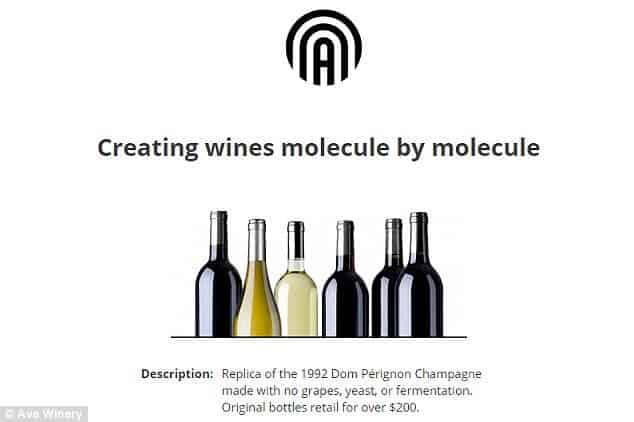Ava Winery, a start-up based in San Francisco, wants to let you enjoy the best of wines for a fraction of their current cost. To this end, they’ll bypass the costly growing and fermentation processes; in fact, they won’t use grapes at all. Their wines will be synthetically produced, by combining aromatic compounds with ethanol.

Mardonn Chua and Alec Lee got the idea in 2015, while visiting a Napa Valley winery. They were shown the bottle of a historic wine for US wineries — a Chateau Montelena, the first Californian Chardonnay rated above its French contenders, at the Paris Wine Tasting of 1976.
“I was transfixed by this bottle displayed on the wall,” says Chua. “I could never afford a bottle like this, I could never enjoy it. That got me thinking.”
Chua started experimenting with ethanol and fruity flavor compounds such as ethyl hexanoate in an attempt to recreate the experience of a quality wine. His first attempts were anything but, Chua himself describing them as “monstrous.” After six months of research however, they now believe they have produced a synthetic wine that can rival a traditionally-produced Italian white Moscato d’Asti sparkling wine. They’re now working on a Dom Pérignon mimic, and will begin shipping of the initial batch of 499 bottles for US$ 50 each later this summer.
An issue of taste
Wine is a very complex chemical solution. It can contain upwards of one thousand different chemical compounds, all working together to give wine its unique flavor. And, even though people have been enjoying this drink since antiquity, we still don’t really know which of these components contribute the most to wine’s taste and finish. The sheer number of different substances and substance interactions makes pinpointing flavor-driving molecules a crucial, but daunting task — like tasting a needle out of a haystack.
The team used gas chromatography, mass spectrometery and other methods to analyze the chemical make-up of several types of wine, such as Chardonnay, champagne and Pinot Noir. They wanted to identify these molecules — such as esters ethyl isobutyrate and ethyl hexanoate — and each of their concentrations. Then, they mixed them into their mimic wine and had a professional sommelier test the results as they experimented with different proportions of these molecules. The result?
“We can turn water into wine in 15 minutes,” claims Ava Winery.
Making wine is a lengthy process; good vines take years to grow, then there’s harvesting, fermenting and aging. A start-up that claims it can cut the whole process down to less than what it takes to order a pizza is naturally going to get the attention of the wine-making industry. Tony Milanowski, a winemaking expert at Plumpton College in the UK, isn’t too convinced about Ava’s mimic wine. Fatty acids and certain esters, released during fermentation in a wine-soluble form, may be difficult to dissolve in a synthetic drink, he says.

Image provided by Ava.
Alain Deloire, director of the National Wine and Grape Industry Centre at Charles Sturt University, Australia, argues that the natural origin of wine has a huge role to play on the quality of the resulting drink, and that customers look for this natural element when they buy wine.
“It’s nonsense, to be honest with you,” Deloire, who has worked for Champagne specialists Moët & Chandon, adds.
Chua and Lee don’t think this will reduce the quality of their product, however.
“The big secret here is that most compounds in wine have no perceptible impact on the flavor or the aroma,” says Lee.
And, cutting to the chase, Lee concludes:
“It’s absolutely going to be substantially cheaper.”
Ava wines are unlikely to be labeled as such, as there are strict rules governing which products can use the term “wine.” The EU only allows it for fermented juice of grapes, whereas in the US other fruits can be used. Although this could damage the allure of synthetic wine, French winemaker Julien Miquel thinks there might be some interest in recreations of classic vintages. c
“There would be some curiosity on how close they could get,” he says.


